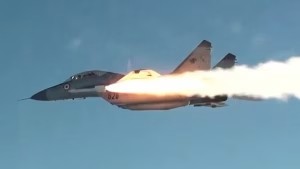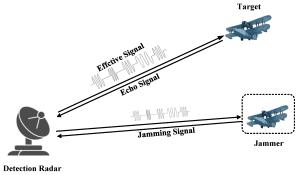New Delhi – In a remarkable display of military prowess, the Indian Air Force (IAF) executed Operation Sindoor between May 7 and 10, 2025, where Chinese air defense jammed by India became the key factor enabling precision strikes on multiple terror camps and military targets across Pakistan and Pakistan-occupied Kashmir (PoK). The government revealed these details on Wednesday, highlighting how Chinese air defense jammed by India demonstrated a strategic and technological sophistication that showcased India’s enhanced military capabilities.
Lightning-Fast Execution Thanks to Defense Jamming

The Chinese air defense jammed by India allowed for exceptional operational efficiency, with the initial strikes completed in just 23 minutes. During this brief window in the early hours of May 7, the IAF and Indian Army precisely targeted nine terror camps in Pakistan and PoK. These targets were meticulously selected based on concrete intelligence about their involvement in terrorist activities against India.
The swift execution caught Pakistan’s defense forces off-guard, as the Chinese air defense jammed by India rendered their systems ineffective, allowing Indian forces to achieve their objectives without any casualties or loss of assets.
Also Read About- Operation Keller: Stunning Success Against3 LeT Terrorists in Kashmir
Strategic Targeting Made Possible by Jamming Technology


With Chinese air defense jammed by India, nine terror camps were successfully targeted, including several high-profile locations with deep connections to terror activities against India:
- Markaz Subhanallah in Bahawalpur: Located approximately 100 km from the International Border, this Jaish-e-Mohammed (JeM) headquarters was the farthest target hit during the operation. The facility was known for recruitment, training, and indoctrination of terrorists.
- Markaz Taiba near Muridke: This Lashkar-e-Taiba (LeT) headquarters led by Hafiz Saeed was situated 25 km inside Pakistan territory. Terrorists involved in multiple attacks on Indian soil, including the 2008 Mumbai attacks, received training at this facility. Notable terrorists such as Ajmal Kasab and David Coleman Headley were trained here before carrying out their attacks.
- Additional targets struck included Mehmoona Joya in Sialkot, Sawai Nala and Syed Na Bilal in Muzaffarabad, Gulpur and Abbas in Kotli, Barnala in Bhimber, and Sarjal near the international border.
The IAF was responsible for destroying the infrastructure at Markaz Subhanallah and Markaz Taiba, while the Indian Army targeted the remaining seven camps, all made possible because Chinese air defense jammed by India created a window of opportunity for these precise strikes.
Advanced Weaponry Deployed Under Cover of Jamming
While Chinese air defense jammed by India provided the critical advantage, the operation also showcased India’s arsenal of advanced weapons systems. The IAF deployed a formidable array of munitions, including:
- Scalp deep-strike cruise missiles, which allowed Rafale fighter pilots to attack ground targets from standoff ranges
- Hammer smart weapon systems, providing precision strike capabilities
- Sukhoi-30-launched BrahMos missiles, demonstrating India’s indigenous missile technology
- Various guided bomb kits for maximum accuracy
Additionally, the operation saw the effective use of loitering munitions, which systematically located and destroyed high-value targets including enemy radar and missile systems. This combination of Chinese air defense jammed by India and sophisticated weaponry highlighted India’s technological advancement in modern warfare.
Technical Details of the Jamming Operation
A key element that ensured the success was the IAF’s ability to bypass and jam Pakistan’s Chinese-supplied air defense systems. This technological feat allowed Indian forces to operate virtually undetected during the critical phases of the operation. Specific details of how Chinese air defense jammed by India was accomplished remain classified, but government sources confirmed that the operation involved sophisticated electronic warfare capabilities that effectively blinded Pakistani radar and communication systems.
The Chinese air defense jammed by India phenomenon demonstrated a significant strategic advantage. While Pakistan’s systems were effectively neutralized, India’s multi-layered air defense grid remained impregnable throughout the operation. This electronic warfare capability not only protected Indian assets but also revealed the vulnerabilities in Pakistan’s supposedly advanced defense systems, which rely heavily on Chinese technology.
Military experts suggest that the Chinese air defense jammed by India revelation has significant implications for other nations in the region that depend on similar Chinese defense systems. The effectiveness of India’s jamming operations indicates a potential technological gap that could influence future defense procurement decisions across South Asia.
Escalation Following Initial Strikes
The initial strikes on May 7, which reportedly eliminated at least 100 terrorists, triggered a series of attacks and counterattacks across the western border. These exchanges involved fighter jets, missiles, armed drones, and intense artillery and rocket duels from both sides.

In a significant counteroffensive, on the night spanning May 9-10, the IAF conducted decisive strikes against 13 Pakistani airbases and military installations. These targets included facilities at Rafiqui, Murid, Chaklala, Rahim Yar Khan, Sukkur, Chunian, Pasrur, Sialkot, Skardu, Sargodha, Jacobabad, Bholari, and Malir Cantt in Karachi. Military analysts have noted that this represented the most severe damage inflicted on Pakistan’s military infrastructure since the 1971 war.
Throughout this escalation, reports indicate that Chinese air defense jammed by India continued to provide a critical advantage, allowing Indian forces to maintain the upper hand despite Pakistan’s attempts to activate backup systems and alternative defense mechanisms.
India’s Impenetrable Defense Systems Contrast with Jammed Chinese Technology
While Chinese air defense jammed by India showcased offensive capabilities, it equally highlighted the effectiveness of India’s defensive systems. Throughout the operation, India’s multi-layered air defense grid functioned flawlessly, neutralizing multiple waves of Pakistani counterattacks targeting Indian military installations, airbases, and civilian areas.


This defensive component relied on a sophisticated integration of air defense assets from the IAF, Army, and Navy, operating in exceptional synergy. The systems, developed and enhanced over the past decade through consistent government investment, proved to be crucial force multipliers during the operation.
India’s air defense grid deployed operated across four levels, based on the distance of incoming threats. The comprehensive array of defensive weapons included:
- S-400 systems for long-range interception
- Medium-range surface-to-air missile systems (Barak 8)
- Pechora air defense systems
- Spyder quick-reaction missiles
- Upgraded L-70 and Zu-23-2B guns
This robust defensive shield ensured that both civilian and military infrastructure across India remained largely unaffected during enemy retaliation attempts. The stark contrast between Chinese air defense jammed by India and the effectiveness of India’s own systems has become a point of military analysis across the region.
Indigenous Technology Behind Jamming Success
A standout aspect of the operation was the seamless integration of indigenous high-tech systems, particularly those responsible for ensuring Chinese air defense jammed by India. From advanced electronic warfare suites to specialized signal processing technologies, India’s homegrown military technology played a central role in making the strikes successful.
The successful implementation of these indigenous systems not only demonstrates India’s growing self-reliance in defense technology but also validates the country’s strategic emphasis on domestic military innovation. The performance of these systems has been hailed as a testament to India’s progress in defense manufacturing, especially in the critical field of electronic warfare that enabled Chinese air defense jammed by India.
Political Context of the Military Operation
The operation was launched in response to the devastating terror attack at Pahalgam in Kashmir on April 22, 2025, where terrorists killed 26 people – all men, 25 of them tourists and 24 Hindu – marking the worst attack on civilians since the 2008 Mumbai strikes.
Following the conclusion of the active phase of Operation Sindoor, the Cabinet Committee on Security, headed by Prime Minister Narendra Modi, met to review the security situation along the western border. This meeting came after the May 10 understanding between India and Pakistan that effectively ended four days of intense military engagement.
The Indian Army’s Director General of Military Operations, Lieutenant General Rajiv Ghai, and his Pakistani counterpart established communication over the hotline to maintain the ceasefire arrangement. Since this communication, neither side has fired shots across the border, though Pakistan has reportedly attempted to violate the ceasefire using drones over Indian cities.
Military analysts suggest that the Chinese air defense jammed by India phenomenon may have profound implications for future conflicts in the region, potentially forcing Pakistan to reconsider its reliance on Chinese defense systems.
Strategic Significance and Future Implications
Prime Minister Modi has made it abundantly clear that the strikes represent a new normal in India’s approach to cross-border terrorism. During a visit to the Adampur air base following the operation, Modi stated, “India’s Lakshman Rekha (red line) against terrorism is now crystal clear. If there is another terror attack, the country will deliver a decisive response. The Indian armed forces have sent a clear message to Pakistan; there is no haven left for terrorists.”
This decisive statement indicates that the success of Chinese air defense jammed by India may have established a new doctrine in India’s strategy for dealing with terrorist threats emanating from across the border. The operation’s success has potentially redrawn the rules of engagement between the two nuclear-armed neighbors.
Military experts suggest that the operation marks a watershed moment in the region’s security dynamics. By effectively neutralizing Pakistan’s air defense capabilities through Chinese air defense jammed by India and conducting precise strikes on terrorist infrastructure, India has demonstrated both the will and the capability to respond forcefully to threats to its security.
International Reactions to India’s Defense Capabilities
The revelation that Chinese air defense jammed by India facilitated the successful strikes has drawn international attention. Defense analysts worldwide are studying the implications of India’s demonstrated ability to neutralize advanced Chinese defense systems.
China, as the original supplier of the air defense systems to Pakistan, has remained officially silent on the matter. However, diplomatic sources suggest that Beijing is closely analyzing the situation to determine the extent to which their exported defense technology was compromised by Indian electronic warfare capabilities.
Other nations that have invested in similar Chinese defense systems are reportedly reassessing the reliability of these purchases in light of the Chinese air defense jammed by India revelation. This could potentially impact China’s position in the global arms market, particularly for air defense systems.
Closing Remarks: A New Chapter in Electronic Warfare
The successful jamming of Chinese air defense systems represents a significant evolution in India’s military capabilities. The operation’s success in neutralizing advanced defense systems, precisely targeting terrorist infrastructure, and withstanding counterattacks demonstrates India’s growing sophistication in electronic warfare.
Beyond the immediate military objectives, the Chinese air defense jammed by India phenomenon sends a clear strategic message about India’s technological capabilities. The operation has established that India possesses not only the technological edge but also the tactical expertise to neutralize supposedly advanced defense systems.
As the dust settles on Operation Sindoor, its long-term implications for regional security dynamics remain to be seen. However, what is certain is that Chinese air defense jammed by India has raised new questions about the effectiveness of Chinese military technology and established India as a significant player in the field of electronic warfare.

